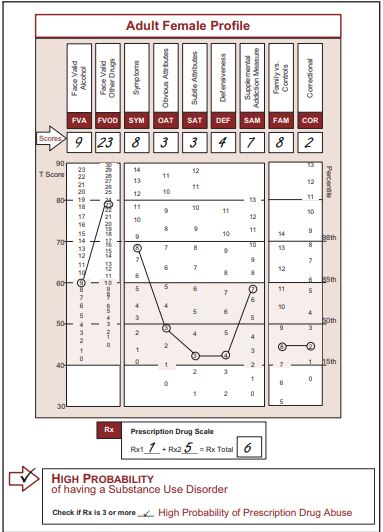Please specify the quantity of product(s).



Substance Abuse Subtle Screening Inventory (SASSI)
| Item | Product | Price | QTY |
|---|---|---|---|
| 31151 | SASSI-4 Adult Kit (includes 25 Record Forms) | $150.00 | |
| 31151L | SASSI-4 Adult Kit (includes 100 Record Forms) | $265.00 | |
| 31151R | SASSI-4 Adult Record Forms, Pk/25 | $65.00 | |
| 31151F | SASSI-4 Adult Record Forms, Pk/100 | $200.00 | |
| 31152 | Spanish SASSI Kit (includes 25 Record Forms) | $65.00 | |
| 31152L | Spanish SASSI Kit (includes 100 record forms) | $195.00 | |
| 31152R | Spanish SASSI Record Forms, Pk/25 | $60.00 | |
| 31152F | Spanish SASSI Record Forms, Pk/100 | $200.00 | |
| 31153 | SASSI-A3 Adolescent Kit (includes 25 Record Forms) | $150.00 | |
| 31153B | COMBO SASSI-A3 Adolescent SASSI-4 Adult Kit 50 each forms | $515.00 | |
| 31153C | COMBO SASSI-A3 Adolescent SASSI-4 Adult Kit 25 each forms | $285.00 | |
| 31153F | SASSI-A3 Adolescent Record Forms, Pk/100 | $200.00 | |
| 31153L | SASSI-A3 Adolescent Kit (includes 100 Record Forms) | $265.00 | |
| 31153M | SASSI-A3 Adolescent User Guide and Manual | $85.00 | |
| 31153R | SASSI-A3 Adolescent Record Forms, Pk/25 | $65.00 |
Substance Abuse Subtle Screening Inventory shows exceptional sensitivity to recognize and flag substance use issues in a number of domains and detect accuracy of reporting.
SASSI assesses a variety of populations. It assesses for presence of drug or alcohol abuse by assessing in functional areas in which those disorders may occur. In addition, the test has a scale for evaluating accuracy of reporting. SASSI provides standard scores in the following domains:
- Face Validity- Alcohol
- Face Validity- Other Drugs
- Symptoms
- Obvious Attributes
- Subtle Attributes
- Defensiveness
- Supplemental Addiction Measure
- Family
- Correctional
Adult Substance Abuse Subtle Screening Inventory – 4 (SASSI-4)
Reading grade Level: 4th – 5th
Accuracy: 92% Based on empirical studies
Administration: 15 minutes to administer and score
The SASSI-A3 identifies high or low probability of substance use disorders in clients 12 to 18 years of age. The SASSI-A3 also provides clinical insight into family and social risk factors, level of defensive responding, and consequences of substance misuse teens endorsed.
Ages: Adolescents 12 to 18 years
Reading Grade Level: 4.4
Accuracy: 94% Based on empirical studies
Administration: 15 minutes to administer and score
Spanish Substance Abuse Subtle Screening Inventory (Spanish SASSI)
Reading Grade Level: 5
Accuracy: 84% Based on empirical studies
Administration: 15 minutes to administer and score
SASSI Kits come with questionnaires and profiles, scoring key, User Guide/Manual. Kits come with specified quantities of forms, which may be ordered additionally as listed above.
References
Adult Substance Abuse Subtle Screening Inventory-4 (SASSI-4)
Lazowski, L.E., & Geary, B.B. (2016). Validation of the Adult Substance Abuse Subtle Screening Inventory-4 (SASSI-4). European Journal of Psychological Assessment. Advance online publication
Adolescent Substance Abuse Subtle Screening Inventory (SASSI-A2)
Lazowski, L. E., & Miller, F. G. (2001). Estimates of the reliability and criterion validity of the Adolescent SASSI-A2. Springville, IN: The SASSI Institute.
Spanish Substance Abuse Subtle Screening Inventory (Spanish SASSI)
Lazowski, L. E., Boye, M. W., Miller, G. A., & Miller, F. G. (2002). The Development and Validation of the Spanish SASSI. Springville, IN: The SASSI Institute.
Behaviors & Attitudes Drinking & Driving Scale (BADDS)
Jewell, J. D., Hupp, S. D. A., Lazowski, L. E., & Miller, G. A. (2007). Reliability and validity summary of the BADDS. Springville, IN: The SASSI Institute.
Substance Abuse Screener in Vocational Rehabilitation Screener2 (SAVR-S2)
Heinemann, A. W., Lazowski, L. E., Moore, D., Miller, F., & McAweeney, M. (2008). Validation of a substance use disorder screening instrument for use in vocational rehabilitation settings.Rehabilitation Psychology, 53(1), 63-72.
Substance Abuse Screener in American Sign Language (SAS-ASL)
Guthmann, D., Lazowski, L. E., Moore, D., Heinemann, A. W., & Embree, J. (2012). Validation of the Substance Abuse Screener in American Sign Language (SAS–ASL). Rehabilitation Psychology, 57(2), 140-148.
Balkin, R. B., & Juhnke, G. A. (2018). Marriage, Substance Abuse, and Suicide Assessment. In Balkin, R.B., & Juhnke, G.A. (Eds.), Assessment in Counseling: Practice and Application. (pp. 200-205). New York, NY: Oxford University Press.
Lazowski, L.E., & Geary, B.B. (2016). Validation of the Adult Substance Abuse Subtle Screening Inventory-4 (SASSI-4). European Journal of Psychological Assessment. Advance online publication. doi: http://dx.doi.org/10.1027/1015-5759/a000359
Lazowski, L. E., Kimmell, K.S., & Baker, S.L. (2016). The Adult Substance Abuse Subtle Screening Inventory-4 (SASSI-4) User Guide & Manual. Springville, IN: The SASSI Institute.
Substance Abuse and Mental Health Services Administration. Using Technology-Based Therapeutic Tools in Behavioral Health Services. Treatment Improvement Protocol (TIP) Series 60. HHS Publication No. (SMA) 15-4924. Rockville, MD: Substance Abuse and Mental Health Services Administration, 2015.
Williams, R. T., Wilson, C. S., Heinemann, A. W., Lazowski, L. E., Fann, J. R., Bombardier, C. H., & U Washington PRISMS Investigators (2014). Identifying depression severity risk factors in persons with traumatic spinal cord injury. Rehabilitation Psychology, 59(1), 50-56.
Heinemann, A. W., Moore, D., Lazowski, L. E., Huber, M., & Semik, P. (2014). Benefits of substance use disorder screening on employment outcomes in state-federal vocational rehabilitation programs. Rehabilitation Counseling Bulletin 57(3), 144-158.
Titus, J. C., & Guthmann, D. (2013). Using evidence-based practices with people who are deaf or hard of hearing. Counselor, 14(3), 68-73.
Guthmann, D., Lazowski, L. E., Moore, D., Heinemann, A. W., & Embree, J. (2012). Validation of the Substance Abuse Screener in American Sign Language (SAS–ASL). Rehabilitation Psychology, 57(2), 140-148.
Laux, J. M., Piazza, N. J., Salyers, K., & Roseman, C. P. (2012). The Substance Abuse Subtle Screening Inventory-3 and stages of change: A screening validity study. Journal of Addictions & Offender Counseling, 33, 82-92.
Winningham, N. & Lazowski, L. E. (2012). The Substance Abuse Screener in American Sign Language (SAS-ASL) User’s Guide. Springville, IN: The SASSI Institute.
Huber, M., Keferl, J. E., Lazowski, L. E., Heinemann, A. W., & Moore, D. (2011). A comparison of didactic and learner-centered training models for substance abuse screening: Considerations for administrators. Journal of Rehabilitation Administration, 35(2), 95-104.
